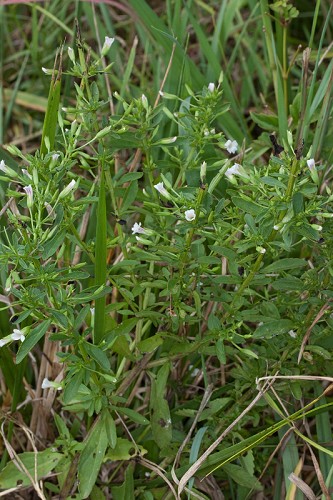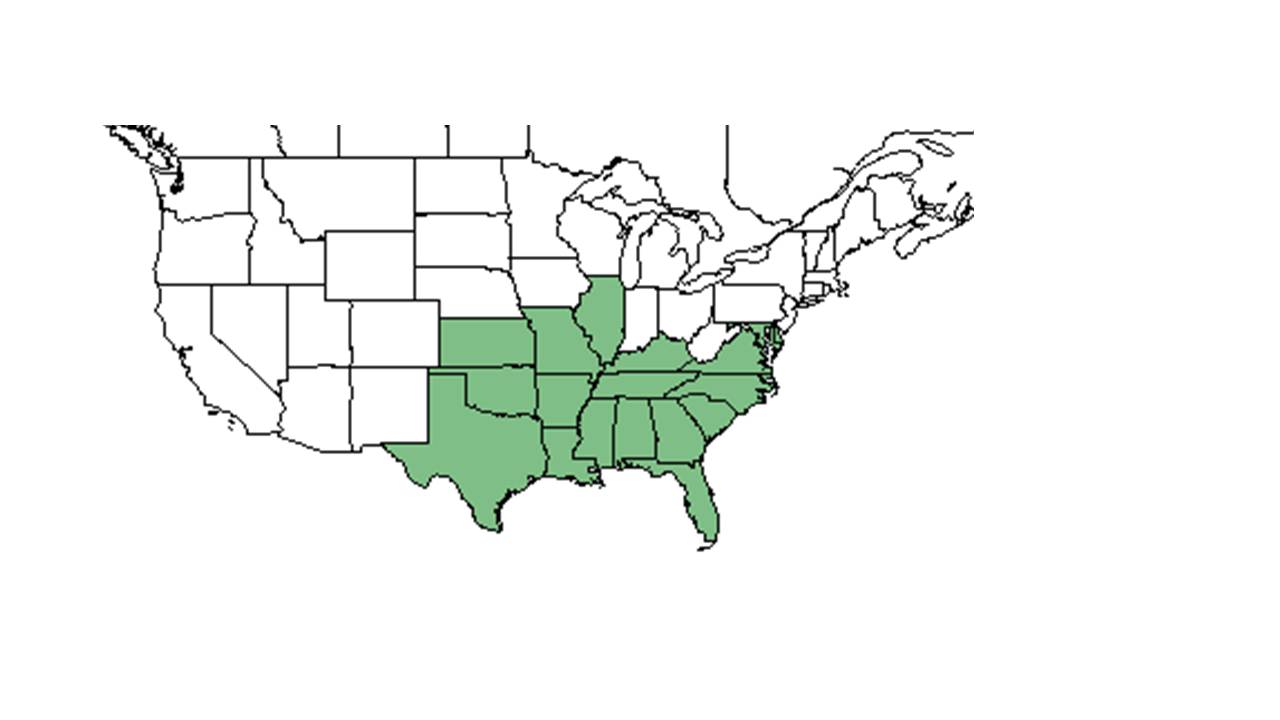Mecardonia acuminata
| Mecardonia acuminata | |
|---|---|

| |
| Photo by John R. Gwaltney, Southeastern Flora.com | |
| Scientific classification | |
| Kingdom: | Plantae |
| Division: | Magnoliophyta - Flowering plants |
| Class: | Magnoliopsida – Dicotyledons |
| Order: | Scrophulariales |
| Family: | Scrophulariaceae |
| Genus: | Mecardonia |
| Species: | M. acuminata |
| Binomial name | |
| Mecardonia acuminata (Walter) Small | |

| |
| Natural range of Mecardonia acuminata from USDA NRCS Plants Database. | |
Common name: Axilflower
Contents
Taxonomic notes
Synonyms: Bacopa acuminata (Walter) B.L. Robinson; Pagesia acuminata (Walter) Pennell ssp. typica; Mecardonia acuminata ssp. acuminata
Description
It has been observed to be both frequent and infrequent where it is found. [1]
"Erect, branched, glabrous perennial, the stems angled, 1-5 dm tall, usually blackening on drying. Leaves opposite, firm, oblanceolate to elliptic, mostly 1-4.5 cm long, 5-12 mm wide, distally serrate, sessile or narrowly cuneate to a short, obscure petiole. Peduncles axillary, solitary, about as long, or longer than the subtending leaf, with 2 linear bractlets at the base; sepals 5, linear-lanceolate, 7-9 mm long; corolla white or tinged with lavender, personate, 9-11 mm long; fertile anthers 4, normal. Capsule ellipsoid, 6-8 mm long." [2]
Distribution
Ecology
Habitat
This species has been found along grassy limestone glades in open areas, in floodplain forests, and savannas. [1] It also can be found in human distrubed areas such as parking areas, powerline corridors, and roadside ditches. [1] This species grows in semi-shaded environments wet, limestone, and sandy loam soils. [1] In Louisiana, soils are upland coastal plain type with little slope and low fertility. [3] Associated species include Sporobolus vaginiflorus, Stenaria nigricans, Polygala grandiflora var. angustifolia, Rhynchospora, Fuirena, and Scleria. [1]
Phenology
This species has been observed flowering in February, August, and September and fruiting in February and September.[1][4]
Seed dispersal
This species disperses by gravity. [5]
Conservation and management
Cultivation and restoration
Photo Gallery
References and notes
- ↑ 1.0 1.1 1.2 1.3 1.4 1.5 Florida State University Robert K. Godfrey Herbarium database. URL: http://herbarium.bio.fsu.edu. Last accessed: June 2014. Collectors: Loran C. Anderson, Ann F. Johnson, Wilson Baker, Robert K. Godfrey, R.A. Norris, R. Komarek, and Lisa Keppner. States and Counties: Florida: Calhoun, Gadsden, Jackson, Jefferson, Leon, Suwannee, Taylor, and Washington. Georgia: Grady.
- ↑ Radford, Albert E., Harry E. Ahles, and C. Ritchie Bell. Manual of the Vascular Flora of the Carolinas. 1964, 1968. The University of North Carolina Press. 938. Print.
- ↑ Thill, R. E. (1983). Deer and cattle forage selection on Louisiana pine-hardwood sites. New Orleans, LA, USDA Forest Service.
- ↑ Nelson, G. PanFlora: Plant data for the eastern United States with emphasis on the Southeastern Coastal Plains, Florida, and the Florida Panhandle. www.gilnelson.com/PanFlora/ Accessed: 12 DEC 2016
- ↑ Kirkman, L. Katherine. Unpublished database of seed dispersal mode of plants found in Coastal Plain longleaf pine-grasslands of the Jones Ecological Research Center, Georgia.